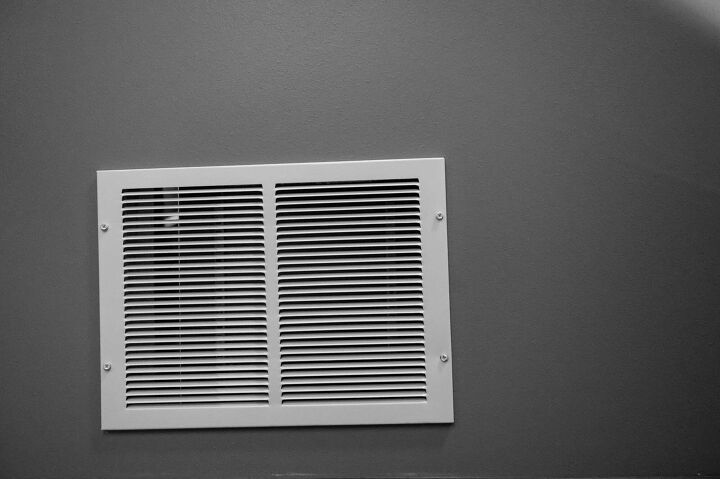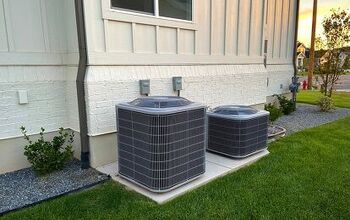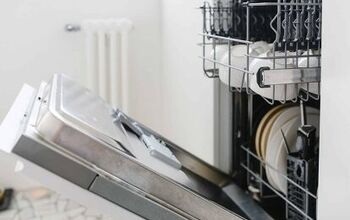How Many Return Air Vents Do I Need?

When you have central air and heat, air vents are typically in each room. Some large rooms have two or three. But what about the return air vents? Do you need one of them or more for each room?
How many return air vents you need depends on your home’s square footage. Many houses, especially older homes, only have one return vent in a central location, which works for a small house (about 800 square feet). However, for consistent air pressure, HVAC professionals recommend one return air vent per room, except for the kitchen and bathrooms.
But there are other things that can make this question more complicated. Things such as keeping bedroom doors shut or having a really large home can mean you will need more than just one or two return air vents in your home. Still, others say that you only need a return air vent in your bedroom if you keep your doors shut often.
Do You Need a Heating and Cooling Contractor?
Get free, zero-commitment quotes from pro contractors near you.

What Do the Vents Do?
Return air vents are just as important as the air vents themselves. The air supply vents push the air out into your home from the HVAC unit. You need equal pressure to take the air back to the HVAC unit. Think of it as your bloodstream. If you have a blockage somewhere, it is going to cause a buildup or possible stroke along with your circulation system eventually.
If you do not have an equal amount of air going back to your HVAC unit, you will have too much pressure going out and not enough coming back in. Eventually, this is going to be a problem. Some of the problems you can have with the lack of sufficient return airflow include warm or cold spots in your home, higher utility bills, damage to the air ducts, damage to your HVAC unit, poor air quality, and high humidity.
How Many Return Air Vents Do I Need?
Generally speaking, you should only need one return air vent per room in your home. However, you may need additional air vents for larger sized rooms. Regardless, the number of return air vents that your home requires depends on the size of your house, the size of the rooms, the ductwork, your particular HVAC system, and a variety of other factors.
For best results, consider having an HVAC professional come out to determine the specific needs of your home, especially if your AC system is causing discomfort. Put simply, if rooms in your home are either too cold or too warm, they may not have a sufficient amount of return air vents.
The efficiency of your HVAC system will not decrease from having too many return air vents. Although, at a certain point, adding return air vents will have no impact.
Hot and Cold Spots in Your Home
Those rooms that do not have return air vents are not going to get good circulation. That means less heat or conditioned air in those spots. Just like your own circulation system, if you do not get enough flow in that area, it can be bad. For example, if you have clogged arteries or veins in your legs, you are likely to have cold feet that can eventually become a health problem.
Higher Utility Bills
Because of those areas of your home that are too hot or too cold, you will likely be turning your air conditioner or heater up or down often. Soon you will see the consequences of this in the form of higher electric or gas bills.
Damage to the Air Ducts
If you have insufficient return airflow, the air is going to be under pressure and will find its own way out. With so much pressure building up in the air ducts, it is likely that the air will eventually find a small crack or weak spot to leak through. The longer this goes on, the worse the leak will become, and you will need to replace the damaged air ducts, which can be expensive.
Damage to Your HVAC Unit
Not having enough air return vents or blocked air return vents puts a lot of pressure on your HVAC system. In time, this will cause overheating or breakdown of certain components. The whole system will be under too much strain and will start to overwork just to get the job done.
Poor Air Quality
You have probably heard of those people who say that they are constantly sneezing or coughing at home but are fine when they are outside. This is probably due to insufficient airflow. Without enough airflow, your home is full of dirty air. The outdoor pollution is finding its way into your home through the leaks that your faulty airflow system is causing.
Too Much Humidity
Without enough return air vents, the air circulation is compromised, which can create humidity. During the summer, the air conditioner is designed to reduce the humidity in the air to make it more comfortable. But when your airflow is compromised, the humidity has no place to go.
Basic Return Duct Sizing
How Does a Duct System Work?
As mentioned above, the duct system in your home is like a circulatory system in your body. Only the duct system circulates the air instead of your blood. The air circulation is apparent when you have either your heater or air conditioner on.
The ducts supply your rooms with cooled or warmed air to keep your home at a comfortable temperature all year long. The system pulls in air through the return air ducts and pushes it out through the supply vents. There are return ducts and supply ducts so that the airflow continues to flow uninterrupted.
When you do not have enough air return vents, the system has to pull air from somewhere else. It will continue to search for small holes or cracks to seep through. Eventually, these small leaks can become major issues and you will notice that your heat or air conditioning is not keeping your home comfortable anymore.
In a proper system, the air return vents send air through the return ducts where it goes through the air handler. The air handler sends the cleaned air back to the air conditioning or heating system where it is sent back through the supply vents. That is why your home needs plenty of air return vents to keep the air flowing unimpeded.
What Can You Do to Fix the Problem?
If you only have one air return vent or you do not have one in each room, you should consider putting air return vents in each room. However, installing a return air vent is not a small job. It involves ductwork and may require a professional.
There is a less expensive and easier way to fix the problem. You can install a transfer grill on the outside of rooms to allow the air to flow when the door is shut. Many homeowners choose to place the grill above the bedroom door or undercut the door with a transfer grill.
Another option is to install a jumper duct. It is like a transfer grill, but it is done with ductwork. This is done by cutting a hole in the ceiling above the door and installing a duct to run to the attic with the other end near the central return grill.
Can You Block or Cover Air Vents?
No matter whether it is an air supply vent or an air return vent, you should never cover them. Not with furniture just because you need the room or with something solid because you think the room is too warm or too cold.
Here are some reasons why this is a bad idea:
- It can cause leaks in the ducts
- The HVAC system compressor can become overworked and stop working
- The lower airflow will make your home uncomfortable
- It can cause air conditioner coils to freeze
- Unbalanced leaks can increase the pollutants in your home
- This may cause a crack in the heat exchanger, which can lead to carbon monoxide in your home
- Mold and condensation can grow during the winter because of lower temperatures
No matter what, do not cover or shut any of your air vents whether they are supply or return vents. This will put pressure on the system, making it work harder than it needs to. Eventually, this will cause a breakdown, and replacing your HVAC system is expensive.
Do You Need a Heating and Cooling Contractor?
Get free, zero-commitment quotes from pro contractors near you.

Clean Your Vents
To ensure that your return air vents are functioning properly throughout the year, they should be maintained. Your air return vents should be kept free of dust and other debris. If they become too dirty, impurities can get sucked into the system and lead to a buildup up debris that will be damaging to the entire system over time.
To clean your return air vents, simply use a vacuum, a wet rag, or a soft cloth and some cleaner. If your return air vents aren’t kept clean, you and your family may end up breathing in polluted air at a much high rate. Regular cleanings of your return air vents will also help you save money on energy costs and expenses related to possible repairs to keep your AC system running efficiently.
Related Guides

I am a DIYer who loves writing about anything home-related. When I am not writing, you can find me studying for my PhD in Psychology, photographing nature, and swimming at the lake with my grandkids.
More by Patricia Oelze




























